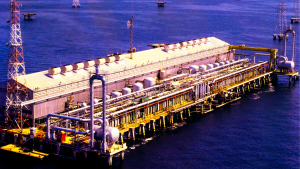The future of offshore oil platforms is undergoing significant changes driven by innovations in design and a growing emphasis on sustainability.
Here are some key trends and advancements shaping the future of offshore oil platforms:
1. Floating Production Systems:
– Floating production systems, such as Floating Production Storage and Offloading (FPSO) vessels, are becoming more prevalent. These floating structures allow for the extraction, processing, and storage of oil at sea, reducing the need for extensive underwater pipelines.
2. Subsea Technologies:
– Advancements in subsea technologies enable the drilling and production of oil and gas directly from the seabed, minimizing surface facilities and reducing environmental impact.
3. Digitalization and Automation:
– The integration of digital technologies, including sensors, automation, and data analytics, enhances operational efficiency and safety on offshore platforms. Predictive maintenance and real-time monitoring contribute to safer and more reliable operations.
4. Decommissioning and Reuse:
– With many aging offshore platforms reaching the end of their operational life, there’s a focus on sustainable decommissioning and, when possible, repurposing structures for other uses, such as artificial reefs or renewable energy installations.
5. Renewable Energy Integration:
– Offshore platforms are increasingly being designed with the potential for integrating renewable energy sources, such as wind or solar power. This hybrid approach helps reduce the carbon footprint of oil and gas operations.
6. Modular and Prefabricated Construction:
– Modular and prefabricated construction techniques are being employed to reduce costs and accelerate project timelines. This approach allows for the assembly of components onshore before transporting them to the offshore location.
7. Green Chemistry and Materials:
– Innovations in materials and the use of green chemistry contribute to more environmentally friendly offshore platforms. Sustainable materials and coatings help protect structures against corrosion and degradation.
8. Electrification of Platforms:
– Electrification of offshore platforms, either through subsea power cables or on-site renewable energy, is gaining traction. This reduces the need for gas turbines and lowers greenhouse gas emissions.
9. Hybrid Power Systems:
– Hybrid power systems that combine traditional energy sources with renewables and energy storage are being explored to optimize energy efficiency and reduce reliance on fossil fuels.
10. Carbon Capture and Storage (CCS):
– Offshore platforms are being considered as potential sites for carbon capture and storage projects. This technology aims to capture carbon dioxide emissions produced during the extraction process.
11. Remote Operations and Robotics:
– Advances in remote sensing, robotics, and autonomous systems enable more efficient and safer offshore operations. These technologies reduce the need for personnel on-site and enhance operational resilience.
12. Regulatory Changes:
– Evolving regulations and industry standards are pushing for more sustainable and environmentally conscious practices in offshore oil and gas activities, influencing the design and operation of platforms.
As the energy industry evolves towards a more sustainable future, innovations in offshore oil platform design and operations play a crucial role in minimizing environmental impact, improving efficiency, and transitioning towards cleaner energy sources.
Read more on Sparkview Energy
Carbon Capture and Storage: A Promising Solution for Emissions Reduction
Adopting and Promoting Renewable Energy Sources for Diversification
A peek at the Horizon of the Oil and Gas industry in the Year 2024







